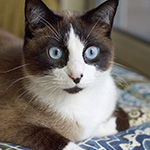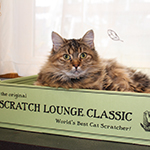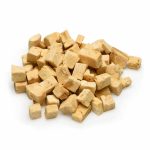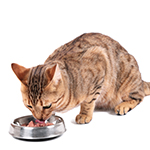Congratulations on your new kitten or adopted cat!
Prepare for an easier transition to your home with these recommended items.
High-quality food
A good quality, high-moisture, meat-based diet is essential for your new cat’s health and happiness. An ideal feline diet contains a variety of canned or raw food instead of dry food alone.
Kittens need frequent feeding for the first six months of life to support their growth and development. Introduce an assortment of tastes and textures while young, to prevent your cat from becoming a finicky eater.
Food dishes
Cat food dishes should be shallow and wide to accommodate whiskers, and made of ceramic, glass, or stainless steel. Avoid plastic dishes—they can harbor bacteria or contribute to feline acne. Deep or steep-sided bowls are harder for cats to eat from, and can cause uncomfortable whisker stress.
Collar and tag
A breakaway cat collar and ID tag will identify your cat if they get lost.
Water bowl or fountain
Water is crucial to feline health and cats are often poor drinkers. Make a water station in a quiet place away from their food (cats instinctively avoid water where they eat) or set up a water fountain, where the moving water will encourage drinking. This can help to encourage better hydration.
Litter, box, and scoop
A high-quality litter will help keep your house free of unpleasant odors. We prefer plant-based clumping litters made from grass, cassava, green tea, wheat, corn, or pine. The box should be large and deep to keep the litter inside. A large, strong, slotted scoop will make cleaning faster. Keep several litter boxes in different locations and scoop daily.
Stain/odor remover
Bring this home before an accident happens. Use an enzymatic cleaner that dissolves the source of stains and odor from carpets, floors, bedding, and clothing to ensure your kitty won’t be drawn back to the same spot. Oxygen-based cleaners can help remove tough or old stains.
Grooming tools
Brushing is a great way to bond with your new kitty. Besides stimulating the skin, it removes loose hair and dander. Use a pin brush or a stainless steel comb for long-haired cats, and slicker brush or rubber curry comb for short-haired cats. FURminator deshedding tools come in both long and short coat versions and make grooming a breeze. Use a scissors-style nail trimmer to keep nails short. Always have a jar of styptic powder on hand in case you nick a quick. A flea comb is an essential tool for finding fleas and removing them.
Beds and mats
 Cats will always seek something soft and warm. Give your kitty their own place and protect your stuff from cat hair with a soft washable throw, mat, or bed. Older cats especially will like our cozy heated pads and self-heating thermal mats. Kitty caves are especially popular with kittens and shy cats who prefer a safe and quiet refuge.
Cats will always seek something soft and warm. Give your kitty their own place and protect your stuff from cat hair with a soft washable throw, mat, or bed. Older cats especially will like our cozy heated pads and self-heating thermal mats. Kitty caves are especially popular with kittens and shy cats who prefer a safe and quiet refuge.
Scratching equipment
 Scratching is essential to feline enrichment. It provides exercise, allows them to mark territory, and removes the outer sheath of their claws. Direct their scratching behavior to scratching posts and/or cardboard scratchers in your house. More options are better, and they will save your furniture. Posts can be simple or elaborate and provide climbing opportunities. Providing at least one vertical and one horizontal scratcher works best.
Scratching is essential to feline enrichment. It provides exercise, allows them to mark territory, and removes the outer sheath of their claws. Direct their scratching behavior to scratching posts and/or cardboard scratchers in your house. More options are better, and they will save your furniture. Posts can be simple or elaborate and provide climbing opportunities. Providing at least one vertical and one horizontal scratcher works best.
Climbing structures and perches
Cats are natural-born climbers and enjoy surveying their territory from high vantage points. Providing cat trees in areas with good views of the most active areas of your home will give your cat the opportunity to climb, perch, and scratch to mark their territory at the same time! A cat tree doubles as an exciting jungle gym for energetic cats and kittens. Fully carpeted trees will provide the most scratching opportunities, while natural driftwood trees make an elegant addition to a room.
Toys
Keep your cat happy, interested, and active with a variety of fabulous toys. Anything with fur, feathers, or movement will elicit their hunting instinct. Wand toys let you interact with your cat, alleviating boredom and preventing obesity. Our favorite wand is the Da Bird with feathers on a swivel that flutter like an actual bird! Puffball-style toys are a lot of fun to bat around and are especially exciting for kittens and young cats. Catnip toys are great too; about 60% of cats respond to catnip. Note that kittens take time to become sensitive to it, so it may not be interesting to a younger cat.
Treats
 Cats love treats, and will actually come to the shaking of the treat bag. The best and healthiest treats are made exclusively from meat or fish. They add high-quality protein to your cat’s diet and won’t cause weight gain like carbohydrate-based treats. There are many delicious options to choose from, including both freeze-dried and high-moisture snacks. Freeze-dried meat treats smell appetizing to cats and can be used for training, food puzzles, and games of chase. Meaty purées are an exciting treat and provide an excellent source of dietary moisture. Because cats lick these treats directly from the tube as you hold it, they also work as a bonding tool.
Cats love treats, and will actually come to the shaking of the treat bag. The best and healthiest treats are made exclusively from meat or fish. They add high-quality protein to your cat’s diet and won’t cause weight gain like carbohydrate-based treats. There are many delicious options to choose from, including both freeze-dried and high-moisture snacks. Freeze-dried meat treats smell appetizing to cats and can be used for training, food puzzles, and games of chase. Meaty purées are an exciting treat and provide an excellent source of dietary moisture. Because cats lick these treats directly from the tube as you hold it, they also work as a bonding tool.
Carrier
A sturdy carrier is necessary for trips to the vet. Plastic carriers are inexpensive and easy to tote.
Preparing Your Home for a New Cat
Redfin reached out to 14 cat experts, from Seattle, WA to Ottawa, ON, including us to gather their best advice on how to prepare your home for a kitty.


